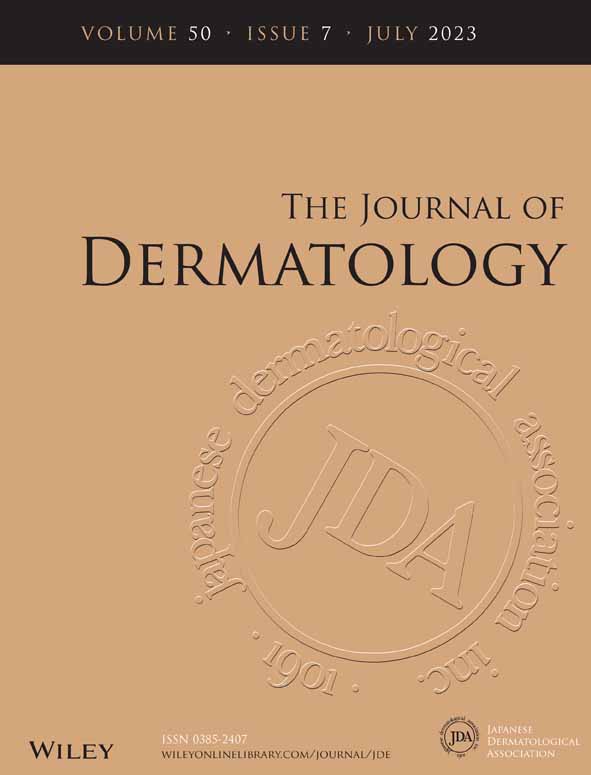Myiasis on a spindle cell squamous cell carcinoma: A scanning electron microscope observation of Lucilia sericata larvae
Ryo Fukaura
Department of Dermatology, Nagoya University Graduate School of Medicine, Nagoya, Japan
Search for more papers by this authorChiaki Terashima-Murase
Department of Dermatology, Nagoya University Graduate School of Medicine, Nagoya, Japan
Search for more papers by this authorShoichiro Mori
Department of Dermatology, Nagoya University Graduate School of Medicine, Nagoya, Japan
Search for more papers by this authorYukiko Higa
Department of Medical Entomology, National Institute of Infectious Diseases, Tokyo, Japan
Search for more papers by this authorCorresponding Author
Masashi Akiyama
Department of Dermatology, Nagoya University Graduate School of Medicine, Nagoya, Japan
Correspondence
Masashi Akiyama, Department of Dermatology, Nagoya University Graduate School of Medicine, 65 Tsurumai-cho, Showa-ku, Nagoya 466-8560, Japan.
Email: [email protected]
Search for more papers by this authorRyo Fukaura
Department of Dermatology, Nagoya University Graduate School of Medicine, Nagoya, Japan
Search for more papers by this authorChiaki Terashima-Murase
Department of Dermatology, Nagoya University Graduate School of Medicine, Nagoya, Japan
Search for more papers by this authorShoichiro Mori
Department of Dermatology, Nagoya University Graduate School of Medicine, Nagoya, Japan
Search for more papers by this authorYukiko Higa
Department of Medical Entomology, National Institute of Infectious Diseases, Tokyo, Japan
Search for more papers by this authorCorresponding Author
Masashi Akiyama
Department of Dermatology, Nagoya University Graduate School of Medicine, Nagoya, Japan
Correspondence
Masashi Akiyama, Department of Dermatology, Nagoya University Graduate School of Medicine, 65 Tsurumai-cho, Showa-ku, Nagoya 466-8560, Japan.
Email: [email protected]
Search for more papers by this authorCONFLICT OF INTEREST STATEMENT
None declared.
REFERENCES
- 1Ishijima H. Revision of the third stage larvae of synanthropic flies of Japan (Diptera: Anthomyiidae, Muscidae, Ca-phoridae and Sarcophagidae). Jpn J Sanit Zool. 1967; 18: 47–100.
10.7601/mez.18.47 Google Scholar
- 2Hiraoka H, Ozawa T, Sowa-Osako J, Ichimura T, Kimata-Teramoto I, Isozumi R, et al. Repeated myiasis in a female vulvar squamous cell carcinoma caused by Lucilia sericata and Sarcophaga crassipalpis. J Dermatol. 2015; 42: 840–1.
- 3Kondoh A, Ota M, Tokuyama M, Makiuchi T, Tachibana H, Mabuchi T. Case of wound Myiasis in a squamous cell carcinoma lesion of the scalp. Tokai J Exp Clin Med. 2022; 47: 44–6.
- 4Munro S, Hadid A, Rahmani MJH. Maggots in the management of ulcer care. BMJ Case Rep. 2017; 2017:bcr2017220462.
- 5King C. Changing attitudes toward maggot debridement therapy in wound treatment: a review and discussion. J Wound Care. 2020; 29: S28–34.
- 6Chambers L, Woodrow S, Brown A, Harris P, Phillips D, Hall M, et al. Degradation of extracellular matrix components by defined proteinases from the greenbottle larva Lucilia sericata used for the clinical debridement of non-healing wounds. Br J Dermatol. 2003; 148: 14–23.
- 7Sherman RA. Mechanisms of maggot-induced wound healing: what do we know, and where do we go from here? Evid Based Complement Alternat Med. 2014; 2014:592419.




